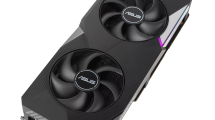Summary
There must be absolutely no shortcoming if a graphics card is not one of the fastest within its product category of factory overclocked cards with the same graphics chip. For the Founders Edition, however, it was still easy. The KFA2 / Galax GTX 1080 Ti EXOC is a very good compromise for a dual-slot card simply because of its comparatively low weight, its narrow and relatively short construction, as well as the appropriately selected settings for clock and power target.

The card still performs in a closed housing without any snapbreathing and also has a sovereign VR cooling system, which also includes the coils and capacitors. However, you should also leave it at the factory clock, because if you really want to make the most of it, you should very quickly come across the physical limits of this design. However, it is and remains a GeForce GTX 1080 Ti, which performs a few single-digit percentage points faster than a Founders Edition and is also significantly quieter. You can live with this if you are not one of the FPS disciples who always want to balance on the last groove.
The only thing that bothers us a little and thus prevents a higher rating is the current price. The street price starts at approx. 750 Euros in reputable online shops and is thus significantly higher than comparable cards, which make much more visually and also tactically. The ALREADY tested MSI GTX 1080 Ti Gaming X 11G is only approx. 5 Euro more expensive and a Zotac GTX 1080 Ti Amp! is even almost 40 euros cheaper. In the end, this also prevents a purchase tip, because despite the dual-slot design, the card does not have enough unique selling points or features to justify its price positioning.
Update from May 22, 2017 – 3:47 PM
As the distributor just told us, the EIA has now been adjusted to a rather appealing 689 euros. The ratios to the performance and the overall impression are also correct for this price, so that we now see the map as a very interesting price/performance tip.
Conclusion*
The KFA2 / Galax GTX 1080 Ti EXOC is a common card whose narrow dual-slot design could be of particular interest to smaller enclosures. It will not be possible to set overclocking records, because the reserves of the very light but still relatively quiet cooler are severely limited. Either one is satisfied with the very well-chosen factory specifications, or one is punished with an increased noise generation, which is disproportionate to the possible clock gain.
What puts the card in focus a little more after the price update (see box above) is the comparatively cheap price, because surely not only those who can't or want to install a much heavier and thicker 2.5-slot design are willing to pay. Then, of course, the narrow waist of the EXOC does itself really well when installed.
*) We adjusted the conclusion to the new prices afterwards, because 749 Euros were simply disproportionate compared to better equipped competitor cards.































Kommentieren